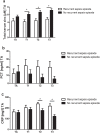Persistent low serum zinc is associated with recurrent sepsis in critically ill patients - A pilot study
- PMID: 28472045
- PMCID: PMC5417428
- DOI: 10.1371/journal.pone.0176069
Persistent low serum zinc is associated with recurrent sepsis in critically ill patients - A pilot study
Abstract
Zinc is an essential trace element for both pathogens and hosts. Hypozincemia is a well known phenomenon in sepsis patients and represents the innate immune systems attempt to deprive pathogens of zinc. However little is known about course, restitution and prognostic value of serum zinc levels in sepsis patients. We performed a prospective observational single-center study set in a tertiary care university hospital intensive care unit. Serum zinc levels were singularly measured of healthy controls and sequentially of surgical sepsis patients and surgical patients over a 8-day period. Throughout the study period, we report significantly decreased serum zinc levels in surgical and surgical sepsis patients compared to healthy controls. Lower serum zinc levels in surgical sepsis patients were associated with a higher susceptibility to a recurrent sepsis episode. Furthermore, surgical sepsis patients with a higher number of organ dysfunctions and increased in-hospital mortality at day 28 and 90 showed lower serum zinc levels at admission. We report serum zinc levels as a promising biomarker in the diagnosis and evaluation of sepsis patients. However, it is still unclear whether these findings are caused by an over-amplified redistribution of zinc during acute-phase response, or whether the critically ill patients were zinc deficient before sepsis.
Conflict of interest statement
Figures



Similar articles
-
Serum oxygen radical activity and total antioxidation capacity are related with severities of surgical patient with sepsis: Prospective pilot study.J Crit Care. 2017 Jun;39:131-136. doi: 10.1016/j.jcrc.2017.01.016. Epub 2017 Feb 12. J Crit Care. 2017. PMID: 28254728
-
Serum selenium and zinc levels in critically ill surgical patients.J Crit Care. 2014 Apr;29(2):317.e5-8. doi: 10.1016/j.jcrc.2013.12.003. Epub 2013 Dec 12. J Crit Care. 2014. PMID: 24411106
-
A comparison of zinc metabolism, inflammation, and disease severity in critically ill infected and noninfected adults early after intensive care unit admission.Am J Clin Nutr. 2011 Jun;93(6):1356-64. doi: 10.3945/ajcn.110.008417. Epub 2011 Apr 27. Am J Clin Nutr. 2011. PMID: 21525204 Free PMC article.
-
Zinc and Sepsis.Nutrients. 2018 Jul 27;10(8):976. doi: 10.3390/nu10080976. Nutrients. 2018. PMID: 30060473 Free PMC article. Review.
-
Assessment of serum zinc, selenium, and prolactin concentrations in critically ill children.Pediatric Health Med Ther. 2016 Apr 4;7:17-23. doi: 10.2147/PHMT.S99191. eCollection 2016. Pediatric Health Med Ther. 2016. PMID: 29388624 Free PMC article. Review.
Cited by
-
Zinc deficiency as a possible risk factor for increased susceptibility and severe progression of Corona Virus Disease 19.Br J Nutr. 2022 Jan 28;127(2):214-232. doi: 10.1017/S0007114521000738. Epub 2021 Mar 1. Br J Nutr. 2022. PMID: 33641685 Free PMC article. Review.
-
"MATH+" Multi-Modal Hospital Treatment Protocol for COVID-19 Infection: Clinical and Scientific Rationale.J Clin Med Res. 2022 Feb;14(2):53-79. doi: 10.14740/jocmr4658. Epub 2022 Feb 24. J Clin Med Res. 2022. PMID: 35317360 Free PMC article. Review.
-
The Role of Diet and Supplements in the Prevention and Progression of COVID-19: Current Knowledge and Open Issues.Prev Nutr Food Sci. 2022 Jun 30;27(2):137-149. doi: 10.3746/pnf.2022.27.2.137. Prev Nutr Food Sci. 2022. PMID: 35919576 Free PMC article. Review.
-
Bioinformatics Analysis Identifies Hub Genes and Molecular Pathways Involved in Sepsis-Induced Myopathy.Med Sci Monit. 2020 Feb 2;26:e919665. doi: 10.12659/MSM.919665. Med Sci Monit. 2020. PMID: 32008037 Free PMC article.
-
Zinc and respiratory tract infections: Perspectives for COVID‑19 (Review).Int J Mol Med. 2020 Jul;46(1):17-26. doi: 10.3892/ijmm.2020.4575. Epub 2020 Apr 14. Int J Mol Med. 2020. PMID: 32319538 Free PMC article. Review.
References
-
- Angus DC, Linde-Zwirble WT, Lidicker J, Clermont G, Carcillo J, Pinsky MR. Epidemiology of severe sepsis in the United States: analysis of incidence, outcome, and associated costs of care. Crit Care Med. 2001;29(7):1303–10. - PubMed
-
- Garnacho-Montero J, Garcia-Garmendia JL, Barrero-Almodovar A, Jimenez-Jimenez FJ, Perez-Paredes C, Ortiz-Leyba C. Impact of adequate empirical antibiotic therapy on the outcome of patients admitted to the intensive care unit with sepsis. Crit Care Med. 2003;31(12):2742–51. Epub 2003/12/12. 10.1097/01.CCM.0000098031.24329.10 - DOI - PubMed
-
- Shanbhogue LKR, Paterson N. Effect of Sepsis and Surgery on Trace Minerals. Jpen-Parenter Enter. 1990;14(3):287–9. - PubMed
MeSH terms
Substances
LinkOut - more resources
Full Text Sources
Other Literature Sources
Medical

